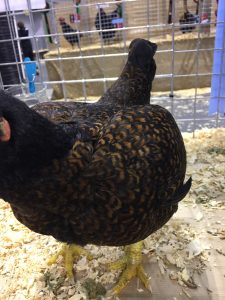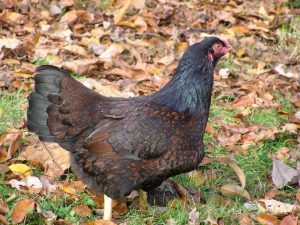Breed Overview
Indian Game Chickens were developed in Cornwall (U.K) for meat purposes, hence it’s other name as the “Cornish”. They are thought to be the breed that is the most popular in the meat industry due to their large muscular body and their ability to be kept in confinement. Both males and females of this breed have a similar physical makeup which is very unusual. Indian Game Chickens are a composite of several different bloodlines – Asell (or Asil), Black-Red, Old English and Malay.
Males weigh around 10.5lbs (4.75kgs) and females weigh around 8lbs (3.6kgs).
Eggs
Size
Small size eggs
Color
Brown color eggs
Production per year
180 per annum
When do they start laying eggs?
From 20 weeks

Indian Game Characteristics
Temperament / Are they good as pets?
They can be aggressive birds and can pick on other chickens. This breed is not ideal to be kept as pets, especially if you have children. They don’t really like free range situations and prefer confinement in smaller spaces. So great if you have a small backyard.

How do I tame Indian Game chickens?
The best way to tame chickens is to pick them up and hold them when they are still really young to get them used to humans quickly. If you have bought chickens older chickens then you can try and tame them by feeding them out of your hand.
How many do I need to buy?
You need to buy at least 2 chickens as they do best when they have some friends. Ideally, you should have a small flock size of 6 chickens.
How much space do they need?
This breed can be kept either free range or in a run. To keep chickens free-range you need at least 25 square feet per chicken. If you keep your chickens in a run the run should have at least 8 square feet per chicken. Preferring confinement they will suit this better than free range roaming.
Will they mix with my other chickens?
Indian game chickens have a reputation for being aggressive so if you want to mix them with your other chickens you should be cautious and make sure that you monitor their behavior.

Appearance
This breed is particularly large and muscular and their body looks heart-shaped when viewed from overhead. There are three types of Indian Game Chicken: Dark Indian, which is identified by a beetle green color with hints of brown; Double laced Indian, which has blue or brown plumage and finally the Jubilee Indian, which has a light brown plumage with white feathers. They have a small pea comb and short, wide-set yellow legs.

Feeding
What should I feed them?
When your chickens first hatch you should be feeding them growers mash, which has a high protein content and lots of vitamins and nutrients to help them grow. You can feed them this until they are 6 weeks, at which point you can switch them to chicken pellets. Chicken pellets are just standard chicken feed in a pelletized form, typically with a 5-16 percent protein content.
At 16 weeks your chickens will need to be fed layers’ mash or layers’ pellets as they need specific nutrients to support them with egg production. Layers’ mash or layers’ pellets usually have around 16 percent protein content.
How much should I feed them?
Chickens eat between 2.9oz (82g) and 4.2oz (120g), but on average eat ¼ of a pound of feed per day. As this breed is on the heavier side, start by feeding them a ¼ of a pound each whilst they are still growing and then raise the feed weight gradually as they grow larger.
What can’t they eat?
There is a detailed list of what should and should not be fed to your chickens on the feed section of our page. The two key foods that you should remember not to feed your chickens are chocolate and beans as they can cause fatalities. This is because chocolate and beans contain theobromine and phytohemagglutinin, which are lethal when consumed by chickens.
As a general rule of thumb, anything that you wouldn’t eat because it has gone off or past its sell-by date, should not be fed to chickens as this can make them seriously unwell.
What do I need to keep chickens?
The first piece of equipment that you need to get your hands on to keep chickens is a coop that should be 4 square feet per chicken. Inside your coop should be wooden laying boxes for your girls to lay their eggs and a perch for each chicken to stand on as they rest.
The coop needs a fence that runs around the perimeter and goes over its roof to protect your chickens at night once you’ve shut them in for bed. If you’re keeping your chickens in confinement you need a run of at least 11 square feet per chicken. If you would like to keep your chickens free-range then you need at least 8+ square feet per chicken. They must always have access to water, make sure to get a sturdy water container and place it out of direct sunlight so that the water doesn’t get warm throughout the day from the sun.
If you have no naturally occurring grit in the area that is accessible to your chickens then you will need to buy some and leave it close by so that your chickens can help themselves.

